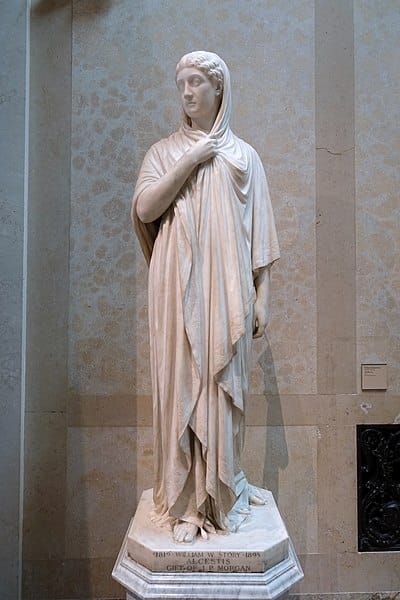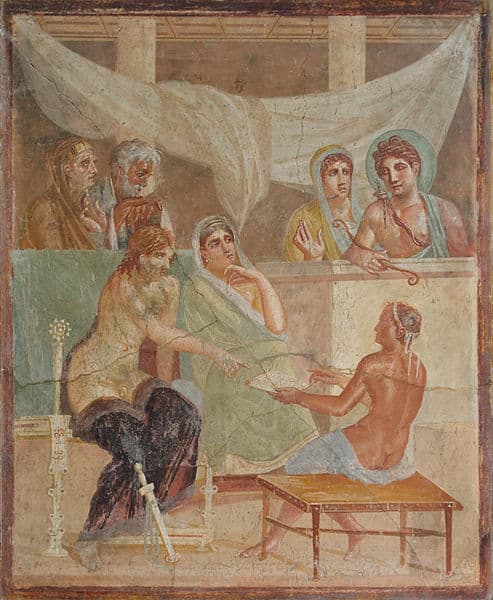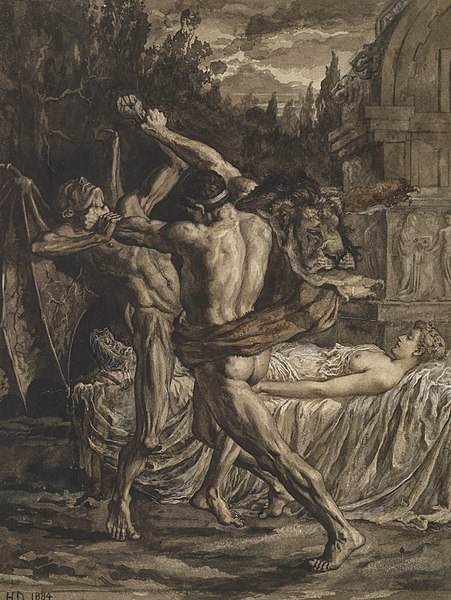In the vast tapestry of Greek mythology, few figures shine as brightly as Alcestis. A heroine not for her prowess in battle or cunning, but for her selfless act of love and sacrifice. Her story, though not as widely recognized as those of Hercules or Achilles, carries a profound message about the depths of human love and the lengths one might go to preserve it.
Alcestis Key Facts
| Parents | Pelias and Anaxibia |
| Partners | Admetus |
| Siblings | Acastus, Peisidice, Pelopia |
| Offspring | Eumelus, Perimele |
| Other names | – |
| Roman name | Alcestis |
| Best Known Myth | Her self-sacrifice for Admetus |
Name and Etymology

Alcestis, a name that resonates with love and sacrifice, has its roots in ancient Greek. The name doesn’t have a direct etymological meaning, but it’s closely associated with her renowned act of selflessness. In Roman myths, she retains her Greek name, a testament to her unique place in mythology. Throughout various texts, she’s occasionally referred to by epithets related to her sacrifice, though “Alcestis” remains the most recognized.
Alcestis’ Family and Relationships
Born to King Pelias and Queen Anaxibia of Iolcus, Alcestis was royalty from the get-go. Her early life, surrounded by siblings like Acastus and Peisidice, was marked by the usual intrigues of a royal household. There’s no significant event marking her childhood, but her life took a dramatic turn when she met Admetus. Their love story is the stuff of legends; she even agreed to die in his place, a testament to their deep bond. This act of sacrifice not only defined her legacy but also showcased the depth of their love.
Myths about Alcestis
Her legend is a poignant tale of love, sacrifice, and redemption. While her story is deeply intertwined with her husband Admetus, it’s her selfless act that sets her apart in the annals of Greek mythology.
The Love of Alcestis and Admetus

Admetus, the King of Pherae, was known for his hospitality and kindness. When Apollo was punished by Zeus and made to serve a mortal, it was Admetus who took him in. Grateful for this act of kindness, Apollo wished to grant Admetus a boon. Admetus, deeply in love with Alcestis, wished to be with her for eternity. Apollo, bound by the fates, couldn’t grant immortality but promised that when Admetus’ time came to die, someone else could take his place if they willingly chose to.
Their love story was the stuff of legends. From the moment they met, there was an undeniable bond between them. Alcestis, the beautiful daughter of King Pelias, had many suitors. But it was Admetus, with Apollo’s help, who won her hand. They were a match made in heaven, deeply in love and devoted to each other.
However, when the fateful day arrived, and Admetus was destined to die, not his parents nor his closest friends were willing to sacrifice their lives for him. It was Alcestis, without a second thought, who stepped forward, ready to give up her life for the man she loved.
Hercules and the Redemption of Alcestis

As word of Alcestis’ sacrifice spread, it reached the ears of Hercules, who was on his way to Pherae. Moved by her act of selflessness and the grief of Admetus, Hercules decided to intervene. He descended into the underworld, confronted Thanatos (Death), and wrestled him to free her soul.
The battle was fierce, but Hercules, with his unmatched strength and determination, managed to overpower Death. He brought Alcestis back from the underworld, but she remained silent and veiled for three days, symbolizing her journey through the realm of the dead. On the third day, she finally unveiled herself and spoke, reuniting with her beloved Admetus.
This act of Hercules not only showcased his strength but also his deep sense of justice and righteousness. While her sacrifice was a testament to human love, Hercules’ intervention was a reminder of the gods’ occasional benevolence and the idea that true love can conquer even death.
In the end, Alcestis and Admetus were given a second chance at love and life, forever indebted to Hercules. Their story, a blend of love’s power and divine intervention, remains one of the most touching tales in Greek mythology.
Depiction And Characteristics
Alcestis, in most depictions, is seen as a woman of ethereal beauty, often accompanied by symbols of love and sacrifice. The ancient Greeks perceived her as the epitome of wifely devotion; her actions in the myths solidify this image. Her willingness to face death, not for glory or honor but for love, sets her apart in a pantheon filled with heroes and gods.
Representations In Art
The poignant tale of Alcestis has inspired countless artists over the millennia. From intricate pottery designs to grandiose paintings, her story has been immortalized time and again. One of the most notable artworks is a fresco in the ancient city of Pompeii, depicting her noble sacrifice. Additionally, many sculptures capture the moment Hercules wrestles with Death, with Alcestis waiting in the balance.
Mentions in Ancient Texts
These works not only narrate her story but also offer different perspectives and interpretations, enriching our understanding of this selfless heroine.
“Alcestis” by Euripides
Euripides, one of the three great tragedians of classical Athens, penned a play titled “Alcestis” in 438 BCE. This drama, though tragic in form, concludes on a hopeful note. In Euripides’ rendition, the hero Hercules plays a pivotal role. After hearing of her sacrifice, Hercules wrestles with Death to bring her back to the living world. This version, with its blend of tragedy and redemption, has become one of the most recognized retellings of Alcestis’ tale.
Bibliotheca of Pseudo-Apollodorus
The Bibliotheca, attributed to Pseudo-Apollodorus (though the actual authorship remains uncertain), is a comprehensive compilation of Greek myths and legends. Written between the 1st and 2nd century CE, it offers an older version of Alcestis’ story. In this narrative, after she willingly gives up her life for Admetus, her spirit descends to the underworld. There, Queen Persephone, deeply moved by her love and sacrifice, commands Death to return her to the realm of the living.
“Alcestis” in Other Works
Beyond these primary sources, her story has found mentions in various other works. Geoffrey Chaucer, in his long poem “The Legend of Good Women,” features Alcestis as a character. John Milton’s sonnet, “Methought I Saw My Late Espoused Saint,” alludes to the myth, drawing parallels between the return of Alcestis and the poet’s vision of his deceased wife. The story has also inspired operas, ballets, and even modern literature, underscoring its timeless appeal.
Frequently Asked Questions
Alcestis sacrificed her life so that her husband, Admetus, could live.
Hercules wrestled with Death to bring Alcestis back to life.
Alcestis was the daughter of King Pelias and Anaxibia.
Yes, the ancient Greek playwright Euripides wrote a tragic play titled “Alcestis.”
Featured Image Credit: George Dennis, Public domain, via Wikimedia Commons
